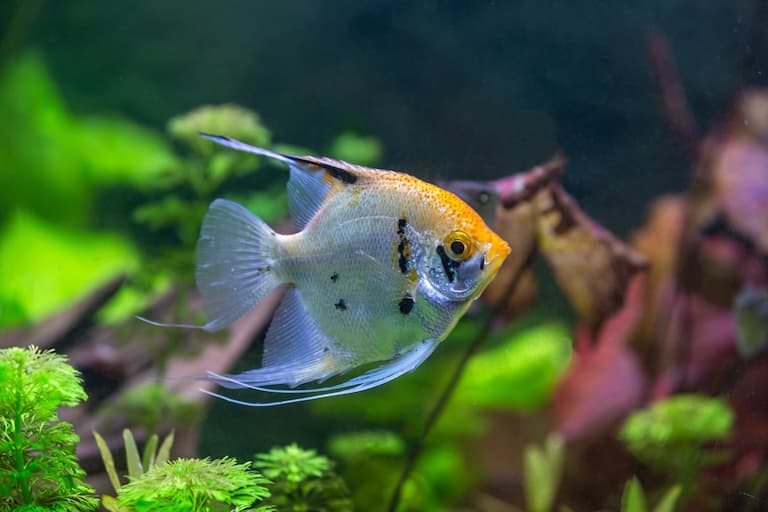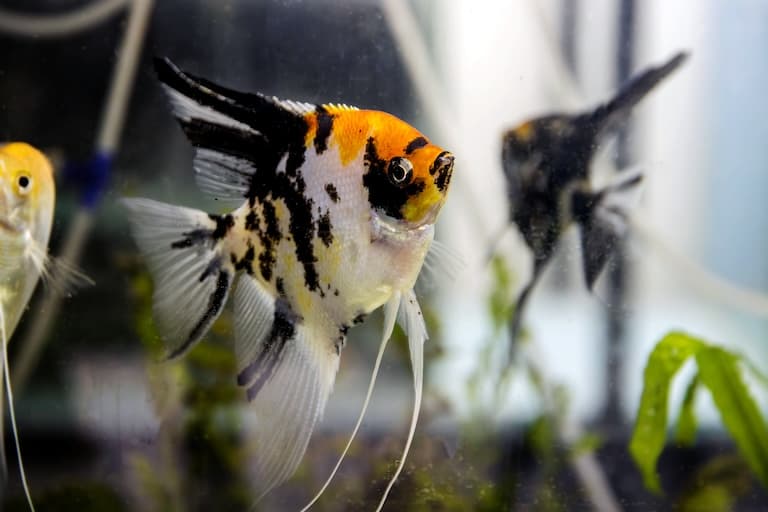Freshwater Angelfish Profile
In the late 1800s, and even well into the 1900s, it was common knowledge in the medical field that babies couldn’t feel pain.
They’re just babies, after all. So, doctors got away with unspeakable torture, blissfully ignorant of the harm they were causing. Everything from injections to open heart surgery was conducted without anaesthetic.
Today, at the very least, this should elicit a deep discomfort in all of us, but more than this, we should be able to look at our past mistakes and use the knowledge to avoid repeating them in the future.
Animals like the angelfish are outstanding representatives of the fish world, aquatic teachers who can show us just how intelligent, lucid, and even relatable fish really are, and, hopefully, make us think twice about some of the things we do to them.

Freshwater Angelfish Facts Overview
| Habitat: | Freshwater systems, swamps or flooded grounds with dense vegetation |
| Location: | Northern South America |
| Lifespan: | 15 in the wild, 12 in captivity |
| Size: | Up to 15 cm (6 in) long |
| Weight: | Around 25 g (o.9 oz) |
| Colour: | Varied, from silvery blues to yellows, with vertical black stripes |
| Diet: | Smaller fish, invertebrates |
| Predators: | Piranhas, peacock bass, giant otters, herons |
| Top Speed: | Not recorded |
| No. of Species: | 3 |
| Conservation Status: | All are Least Concern |
Angelfish, or freshwater angelfish are a small genus of very pretty tropical fish whose toughness and beauty have made them extremely popular in the aquarium trade.
They are an entirely different order of animal from the [marine angelfish], though equally good-looking.
These cichlids are unusual, even for their own family, being more laterally compressed than usual, and with ornate fins; but far more fascinating is their ability to talk, count and possibly even grieve; traits that they may have retained for longer than our ancestors have been on land, yet all things we’re only just now starting to notice.
Interesting Freshwater Angelfish Facts
1. They’re Cichlids
Cichlids originated from South America, around 67 million years ago, and from there became an enormous family of very widespread fishes. It is, in fact, one of the largest single families of vertebrates there is, and new species are being added to the list to this day.
There are likely around 2,000 species of cichlid, with some of the more famous examples being tilapia and the convict cichlid. Being so widespread, they’re a very common food fish in tropical regions but there’s more to them than this.
They’re known to have radiated very fast, diverging into species that are closely related but very different in appearance due to the specific niches they occupy. Angelfish are a great example of this.

2. They’re flat
Angelfish are far more squashed at the sides than most other cichlids, making them flat vertically, and hard to see when they’re coming straight for you.
They have round bodies and vertical stripes, two more adaptations that tie into where this fish lives. In the wild, they are ambush predators, occupying densely crowded waterways like swamps. They hunt in clear water, in dappled light, hiding like tigers among the grass. 1

3. They’re monogamous
Cichlids are known for being quite protective of their young, and angelfish are no exception. Males will court a female, and after laying, both will protect the eggs and one another against aggression.
They form strong bonds with one another, to the point where a bonded fish may even refuse to mate with anyone other than his or her chosen companion, even after their partner’s death. Just like in humans, the length of time an angelfish will stay bonded with its mate varies.
4. They communicate
All cichlids are now known to communicate using a wealth of tools at their disposal. These include chemical, visual, tactile and even acoustic communications.
Sounds, like grunts, purring or thumps have been documented in at least 16 species, and people who keep angelfish in captivity report hearing sounds from their tanks too.
The scientific understanding of the minds of fish is well behind that of other terrestrial animals, but it’s rapidly on the rise, and angel fish are a good place to start.
5. They can identify quantities
In experiments, angelfish – who prefer to gather in shoals for protection – have been demonstrated to be able to tell the difference between smaller and larger groups.
The granularity of this ability is still being teased out, but a follow-up study to these experiments showed that they can tell the difference between 3 vs 2 and 2 vs 1, but got a little more confused when the ratios became smaller.
This shows at least a spontaneous discrimination of small quantities in line with other vertebrate species, even humans, who need to lean on counting after four or five items, too. These kinds of smarts, combined with their natural beauty have unsurprisingly made them quite popular. 2
6. They’re popular in tanks
Angelfish are one of the more common species found in freshwater aquaria and are the most commonly kept cichlid.
Most are now captive-bred, which brings with it issues of poor genetic stock, but keeps the wild populations safe from harvest.
They’re commonly known as semiaggressive, or by some to be “territorial, but not aggressive”, for their protective nature, but they show clear personalities, and curiosity, and are hardy animals that do well if their basic requirements are met. 3

7. They can be hard to look after
But basic needs can be no easy task with a fish that can live for 12 years, and with the aforementioned genetic issues, a lot of them don’t make it past 5 in captivity.
These are interactive and playful animals that require stimulation, and their inquisitive minds therefore need enrichment in the aquarium in the form of friends and interactive surroundings. 4
8. A highschooler sequenced their DNA
In a fantastic example of the democratisation of science, a 17-year-old high school student used a portable nanopore sequencing device called MinION to sequence the DNA of his dead pet fish.
He put it up on social media and was immediately the talk of the molecular biology community. The DNA sequence became the first such record for the angelfish.
Freshwater Angelfish Fact-File Summary
Scientific Classification
| Kingdom: | Animalia |
| Phylum: | Chordata |
| Class: | Actinopterygii |
| Order: | Cichliformes |
| Family: | Cichlidae |
| Genus: | Pterophyllum |
Fact Sources & References
- “Angelfish”, IUCN Red List.
- Luis M. Gómez-Laplaza (2011), “Spontaneous discrimination of small quantities: shoaling preferences in angelfish (Pterophyllum scalare)”, Springer Nature Link.
- Luis M. Gómez-Laplaza (2010), “Can angelfish (Pterophyllum scalare) count? Discrimination between different shoal sizes follows Weber’s law”, Springer Nature Link.
- Kevin McLean (2022), “How Long Do Angelfish Live? – Improving Their Lifespan”, petfish101.
